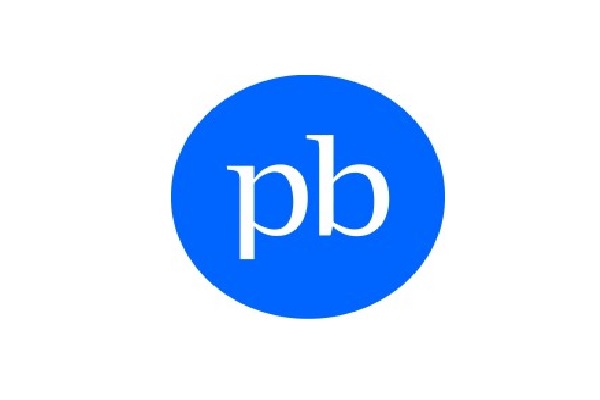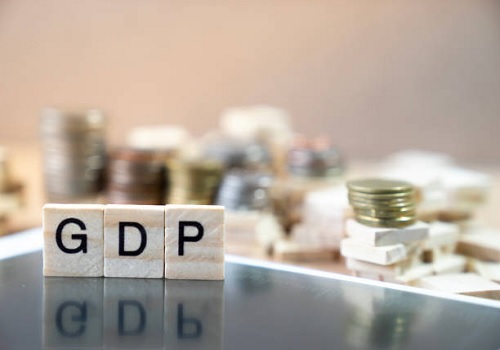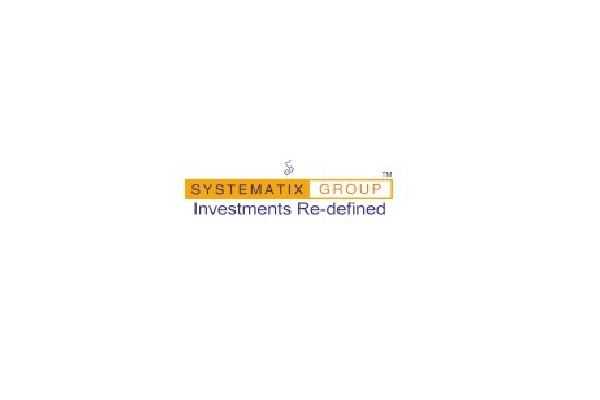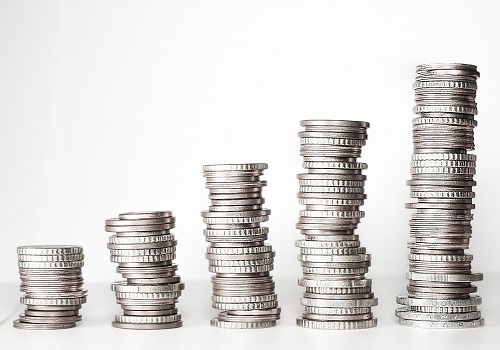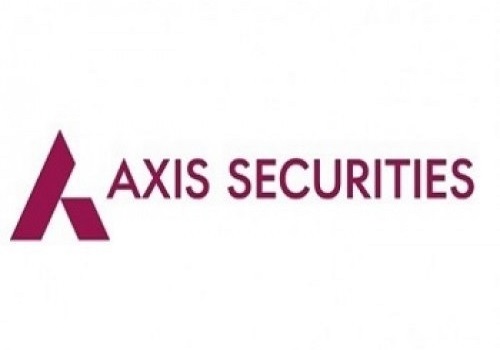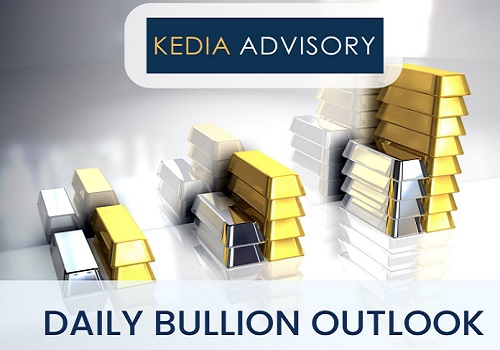Jeera trading range for the day is 18900-19400 - Kedia Advisory

Gold
Gold prices slipped by 0.91% yesterday, settling at 99,417, pressured by easing safe-haven demand following a string of new trade deals that lifted investor sentiment. President Trump’s announcement of a significant trade agreement with Japan, including lower-than-expected reciprocal tariffs of 15% instead of the threatened 25%, boosted risk appetite and overshadowed gold’s appeal as a hedge. Similar agreements with the Philippines and Indonesia further dampened demand for bullion, although uncertainty persists with negotiations with the EU and other key partners still deadlocked. Meanwhile, market focus is shifting to next week’s Federal Reserve meeting, where the central bank is widely expected to keep rates unchanged, with traders now eyeing potential rate cuts later in October. On the physical side, Swiss gold exports rose sharply by 44% month-on-month in June, driven by increased shipments to the UK, which received 83.8 metric tons — the highest since August 2019 — reflecting robust vault demand in London. Despite this, India’s domestic gold demand remained weak as near-record prices discouraged retail buyers, forcing dealers to widen discounts to $10 an ounce over official prices compared to $8 previously. India’s gold imports in June plunged 40% year-on-year to 21 tons, the lowest in more than two years. Technically, the market is under long liquidation as open interest dropped by 16.71% while prices slipped by 912 rupees. Gold now finds support at 98,915, with a break below exposing 98,410, while resistance is likely at 100,240; a move above this could open the door to test 101,060.
Trading Ideas:
* Gold trading range for the day is 98410-101060.
* Gold prices dipped as new US trade deals reduced safe-haven demand for the metal.
* Trump’s “massive” trade pact with Japan sets 15% tariffs, lower than earlier threatened 25% rate.
* EU trade talks with the US remain deadlocked, with Brussels preparing retaliation for a possible no-deal outcome.
Silver
Silver prices ended marginally lower by 0.02% yesterday, settling at 115,634, as a wave of renewed trade optimism dulled the metal’s appeal as a safe haven. Markets responded to President Trump’s announcement of a fresh trade agreement with Japan, which features a reciprocal 15% tariff, alongside news that the ongoing tariff truce with China may be extended, with further talks set for next week in Stockholm. These developments lifted investor sentiment, reducing immediate hedging demand for silver. Adding a layer of uncertainty, however, were President Trump’s sharp comments against Federal Reserve Chair Jerome Powell, accusing him of keeping rates too high and indicating he could be replaced within eight months — fueling fresh speculation around the Fed’s future monetary stance. On the macro front, weaker-than-expected US existing home sales, which fell 2.7% to a 3.93 million-unit annual pace in June, highlight lingering economic headwinds despite robust housing prices. Meanwhile, structurally, silver remains well-supported by strong fundamentals. Demand dynamics remain favorable, with industrial fabrication forecast to grow by 3% in 2025 and physical investment seen rising further, even as jewelry demand contracts, especially in India due to high local prices. Technically, silver is under fresh selling as open interest rose by 0.84% while prices edged down by 21 rupees. Support is pegged at 115,010 and a break below could test 114,385, while resistance is seen at 116,450 — a move above this could open the door towards 117,265.
Trading Ideas:
* Silver trading range for the day is 114385-117265.
* Silver drops from record highs as US trade deals spur fresh market optimism
* Trump’s new US-Japan trade deal imposes a 15% tariff on Japanese exports, boosting market focus.
* Trump’s renewed criticism of Fed Chair Powell increased uncertainty around future US monetary policy direction.
Crude oil
Crude oil prices edged up by 0.16% yesterday to close at 5,655, supported by a sharper-than-expected draw in U.S. crude inventories and optimism surrounding fresh trade deals. The U.S. Energy Information Administration (EIA) reported that crude oil inventories fell by 3.169 million barrels in the week ending July 18, significantly exceeding market expectations of a 1.6 million barrel drop. This drawdown came as U.S. crude exports climbed by 337,000 barrels per day (bpd) to reach 3.86 million bpd, while net imports declined by 740,000 bpd. Meanwhile, the Strategic Petroleum Reserve saw its first withdrawal since December 2023, with 300,000 barrels released to aid refinery operations. Additionally, the U.S. Energy Department’s move to allow ExxonMobil to borrow up to one million barrels underscores the administration’s flexible approach to supply management amid fluctuating market conditions. On the supply side, OPEC’s latest outlook is slightly more bullish, projecting a 1.29 million bpd increase in global oil demand for 2025, mainly driven by non-OECD countries. U.S. production is now forecast to reach 13.37 million bpd in 2025, down from last month’s estimate of 13.42 million, reflecting lower prices and geopolitical uncertainties, including new sanctions on Russian crude and President Trump’s tariff policies. Technically, crude oil remains under fresh buying pressure, with open interest rising by 1.49% to 11,802 while prices advanced by 9 rupees. Immediate support stands at 5,612 and a break below may test 5,569, while resistance is now seen at 5,691 — a move above this could extend gains toward 5,727.
Trading Ideas:
* Crudeoil trading range for the day is 5569-5727.
* Crude rebounds on big US inventory drop, focus on trade talks, signed deals
* US government data showed crude inventories fell by 3.17 million barrels last week, more than expected.
* U.S. crude exports were up by 337,000 barrels per day (bpd) to 3.86 million bpd.
Natural gas
Natural gas prices fell sharply by 5.05% yesterday to settle at 266.8, weighed down by near-record production levels and expectations of milder weather reducing immediate cooling demand. Although temperatures in the Lower 48 states are forecast to remain hotter than normal through early August, the revised outlook now anticipates less intense heat than previously expected, which has dampened market sentiment and curtailed buying interest. On the supply side, production remains robust, with average output in the Lower 48 hitting 107.2 billion cubic feet per day (bcfd) so far in July, surpassing June’s record high of 106.4 bcfd. Strong supply is expected to sustain healthy storage injections despite ongoing summer heat. The latest EIA data showed that U.S. utilities injected 46 billion cubic feet (bcf) into storage for the week ending July 11, lifting total inventories to 3.052 trillion cubic feet (tcf) — about 6.2% above the five-year seasonal average. Looking ahead, the EIA projects that both U.S. output and demand will hit record highs in 2025, with dry gas production forecast to rise to 105.9 bcfd and LNG exports expected to increase to 14.6 bcfd, further tightening the global market over the medium term. Technically, the market is under fresh selling pressure, with open interest rising by 8.28% to 15,095 contracts while prices dropped by 14.2 rupees. Immediate support for natural gas is at 260.8, with a break below potentially testing 254.8. On the upside, resistance is seen at 277.4 — a move above this level could lift prices towards 288.
Trading Ideas:
* Naturalgas trading range for the day is 254.8-288.
* Natural gas fell pressured by near-record output and forecasts for milder weather than previously expected.
* Temperatures stay hotter than normal through August 6, but revised models show reduced heat intensity overall.
* Stockpiles remain robust, standing about 6% above the five-year seasonal average, helping cap price upside.
Copper
Copper prices ended slightly higher by 0.04% yesterday, settling at 898.4, as the market balanced fresh U.S. tariff measures with resilient global fundamentals. The U.S. confirmed that refined copper will face new tariffs aimed at boosting domestic refining capacity, sending the premium for U.S. copper over comparable LME futures to a record 30%. This tariff move comes at a critical time, as the U.S. relies on imports for nearly half its copper needs, with Chile its main supplier. Globally, copper supply continues to improve. Chile’s state-run Codelco reported a 9% rise in output for H1 2025, while Antofagasta’s production jumped 11% to 314,900 metric tons over the same period. Despite these gains, the International Copper Study Group (ICSG) noted that the global refined copper market posted a 97,000 metric ton surplus in May, reversing a deficit seen in April. For the first five months of 2025, the market maintained a surplus of 272,000 metric tons. China’s copper imports rebounded 8.7% in June to 464,000 metric tons, ending a two-month decline. However, imports remain lower year-to-date as traders shift stockpiles to the U.S. ahead of the tariff implementation on August 1. Technically, the market is under short covering, with open interest down by 12.02% to 3,200 lots while prices edged up 0.4 rupees. Copper finds immediate support at 895.8; a drop below may test 893.1. Resistance is now seen at 901.5, with a breakout above potentially extending gains to 904.5.
Trading Ideas:
* Copper trading range for the day is 893.1-904.5.
* Copper surged as the impact of US tariffs on copper were magnified by softer pessimism on manufacturing.
* COMEX copper hits record high as August 1 tariff deadline looms.
* The global refined copper market showed a 97,000 metric tons surplus in May - ICSG
Zinc
Zinc prices edged up by 0.3% to close at 269.65, supported by renewed optimism in the metals complex after President Trump secured a trade deal with Japan, sparking hopes for further easing of trade tensions with China. This optimism is set to be tested next week as U.S. and Chinese officials meet in Stockholm, a development metals traders will closely watch given China’s dominant role in global base metals demand. The latest International Lead and Zinc Study Group data showed that the global zinc market swung to a deficit of 44,100 metric tons in May from a surplus in April, a clear sign of tightening supply conditions. However, over the first five months of 2025, the market still shows a surplus of 88,000 tons — narrower than the 214,000-ton surplus seen during the same period last year, highlighting a gradual tightening trend. Meanwhile, supply-side pressures persist as some Chinese smelters cut production due to low treatment charges and weather-related disruptions, with heavy rains impacting South China operations. Global supply risks are further amplified by Teck Resources’ Red Dog Mine facing declining output and Australian smelter Nyrstar’s decision to slash production by 25% this year. Technically, the market is under short covering as open interest dropped by 8.95% to 2,411 while prices climbed by 0.8 rupees. Zinc finds immediate support at 268.1; a drop below could test 266.6. On the upside, resistance is seen at 271 — a break above may lift prices towards 272.4.
Trading Ideas:
* Zinc trading range for the day is 266.6-272.4.
* Zinc gains as sentiment was boosted after U.S. President Donald Trump struck a trade deal with Japan.
* The global zinc market swung to a deficit of 44,100 metric tons in May from a surplus of 17,300 tons in April.
* China’s stimulus for machinery, autos and electrical sectors supported broader industrial metals sentiment.
Aluminium
Aluminium prices slipped by 0.49% to settle at 253.75, as cautious trading persisted amid close monitoring of the ongoing U.S.-China trade discussions. Despite the slight decline, downside was limited by Beijing’s recent pledge to stabilize industrial growth through massive infrastructure investments, highlighted by the announcement of a CNY 1.2 trillion hydroelectric project. This signals stronger medium-term demand for industrial metals like aluminium as China seeks to support its real economy sectors. Global supply trends presented mixed cues. According to the International Aluminium Institute, global primary aluminium output in June rose by 0.9% year-on-year to 6.045 million tonnes, while China’s production in June increased by 3.4% year-on-year to 3.81 million tonnes. However, on a monthly basis, China’s output dipped by 3.23% in June, hinting at tighter supply conditions in the short term, even as domestic operating capacity is expected to stay high through July. Meanwhile, signs of weaker demand appeared in the form of softer Japanese import premiums for the upcoming quarter, which fell by 41% to $108 per metric ton amid ample supply. Aluminium inventories at Japan’s key ports dropped 4.3% on the month, while SHFE-monitored stocks rose by 5.5% week-on-week, pointing to mixed regional stock dynamics. Technically, the market is under long liquidation with open interest falling by 8.61% to 1,826 lots, while prices dropped by 1.25 rupees. Aluminium finds support at 252.7; below this, prices could test 251.7. Resistance is pegged at 255, with a break above possibly pushing prices to 256.3.
Trading Ideas:
* Aluminium trading range for the day is 251.7-256.3.
* Aluminium fell as traders closely watched progress in China–U.S. trade talks for clearer direction.
* Beijing’s pledge to stabilize industrial growth and infrastructure spending capped aluminium’s downside despite weak sentiment.
* Global primary aluminium production rose 0.9% YoY to 6.045 million tonnes in June, IAI data showed.
Cottoncandy
Cottoncandy prices edged slightly higher by 0.09% to close at 55,900 as short covering supported the market after recent declines driven by heavy closing stock estimates and higher domestic production. According to the Cotton Association of India (CAI), closing stocks for the current 2024–25 season are pegged at around 55.59 lakh bales, significantly higher—by nearly 84%—than last year’s 30.19 lakh bales. CAI’s updated projections show pressing numbers for the season rising to 311.40 lakh bales, reflecting a better crop size. Total supply till end-June is estimated at 356.76 lakh bales, combining pressings, imports of 30 lakh bales, and opening stocks. Domestic consumption is seen slightly higher at 308 lakh bales, while exports are projected to fall steeply by 40% year-on-year to 17 lakh bales, indicating muted overseas demand. Interestingly, imports are pegged at 39 lakh bales—more than double last year’s levels—highlighting the changing dynamics of the domestic market. Globally, the U.S. cotton balance sheet for 2025/26 reflects higher production and ending stocks, with planted and harvested areas increasing despite a marginal drop in average yields. Ending stocks in the U.S. are expected to rise by 300,000 bales to 4.60 million, resulting in a stocks-to-use ratio of 32.4%. Technically, the market remains under short covering, evident from a significant drop in open interest by 45.45% to 18 lots, while prices gained 50 rupees. Immediate support lies at 55,770; if breached, prices could test 55,640. On the upside, resistance is likely at 56,110, with a breakout potentially pushing prices to 56,320.
Trading Ideas:
* Cottoncandy trading range for the day is 55640-56320.
* Cotton gains on short covering after prices dropped as 2024-25 closing stocks seen 84% higher at 55.59 lakh bales
* CAI cut consumption forecast by 8 lakh bales to 307 lakh for the 2024–25 season.
* Cotton exports expected to fall to 15 lakh bales, down 13.36 lakh from last year.
* In Rajkot, a major spot market, the price ended at 27473.65 Rupees gained by 0.17 percent.
Turmeric
Turmeric prices slipped by 0.47% yesterday, settling at 13,200, pressured by expectations of increased acreage amid favourable monsoon conditions this sowing season. Daily arrivals rose to 13,660 quintals from 11,940 quintals in the previous session, signaling a marginal uptick in availability. Dry weather has supported timely sowing, and early estimates suggest turmeric acreage could expand by 15–20% as growers prefer turmeric over other crops due to better profitability prospects. For the 2024–25 season, the turmeric area is projected at 3.30 lakh hectares — up about 10% from the previous year’s 3 lakh hectares. However, the downside remains capped by concerns over actual output. Despite a larger planted area, productivity may fall due to untimely rains, with new crop yields estimated to be 10–15% lower, especially in the Nanded region where small rhizomes and crop rots have been reported. On the market side, fresh arrivals at the Duggirala market continue to command a premium over older stock thanks to their better quality, sustaining strong buying interest even as the season winds down. Adding a positive note, turmeric exports rose by 8.37% to 34,162.28 tonnes during April–May 2025 compared to the same period last year. Exports in May alone surged over 28% month-on-month. Technically, the market is witnessing long liquidation with open interest dropping by 0.37% as prices fell by 62 rupees. Turmeric now finds support at 13,142, with a break below likely to test 13,086, while resistance is seen at 13,272; a move above could push prices to 13,346.
Trading Ideas:
* Turmeric trading range for the day is 13086-13346.
* Turmeric prices dropped due to expected increase in acreage.
* Turmeric acreage is expected to increase by 15-20% this season, supported by low competitive crop prices.
* In April 2025 around 14,956.80 tonnes were exported as against 14,109.10 tonnes in April 2024 showing a rise of 6%.
* In Nizamabad, a major spot market, the price ended at 14027.4 Rupees dropped by -0.2 percent.
Jeera
Jeera prices extended their decline yesterday, settling down by 0.8% at 19,130 amid sluggish domestic and export demand following the end of the retail season. Traders highlighted that with the retail buying phase now over, activity from overseas buyers remains limited, keeping the market under pressure. Adequate available stocks and comfortable supplies have further dampened sentiment, with farmers reportedly holding about 20 lakh bags of cumin. Of this, only 3–4 lakh bags are expected to be traded by the end of the season, leaving a significant carry-forward stock of nearly 16 lakh bags — a factor weighing on market confidence. Although India’s jeera production for the current season is expected to be slightly lower at around 90–92 lakh bags versus last year’s 1.10 crore bags due to reduced sowing in some areas, this marginal drop has not been enough to offset the impact of weak demand. On the global front, geopolitical issues in key producing regions like Syria, Turkey, and Afghanistan have reduced their supplies, but this has yet to translate into significant additional export traction for Indian jeera. Exports during April–May 2025 fell sharply by over 27% year-on-year to 42,925.74 tonnes, although May shipments alone rose by 11.26% from a year earlier and jumped 17.68% month-on-month, indicating some improvement in recent overseas orders. Technically, jeera remains under fresh selling pressure as open interest increased by 0.93% while prices declined by 155 rupees. Jeera finds support at 19,020, with a break lower likely to test 18,900, while resistance is seen at 19,270; a move above could push towards 19,400.
Trading Ideas:
* Jeera trading range for the day is 18900-19400.
* Jeera prices dropped due to weak domestic post retail season.
* Only 3-4 lakh bags are expected to be traded by the end of the season, leaving a carry-forward stock of about 16 lakh bags
* Total arrivals witnessed a marginal increase to 12,000 bags as against 11,800 bags on the previous day.
* In Unjha, a major spot market, the price ended at 19797.1 Rupees dropped by -0.33 percent.
Views express by all participants are for information & academic purpose only. Kindly read disclaimer before referring below views


